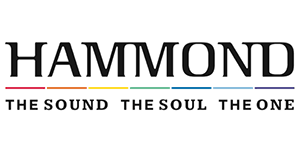
Электромузыкальная продукция Hammond, ставшего одним из самых популярных и известных брендов Америки, начала выходить в 1935 году в виде первого промышленного клавишного инструмента ‒ органа Hammond. Он позиционировался как более доступная альтернатива церковным органам и как инструмент для музицирования в домашней обстановке. Бренд получил своё название благодаря его основателю Лоуренсу Хаммонду ‒ американскому инженеру и изобретателю. Кроме своего самого известного изобретения ‒ электрооргана, Хамонд стал создателем и «Hammond Clock», а также первого полифонического синтезатора Novachord.
Однако изобретательская деятельность создателя легендарного синтезатора началась далеко не с музыкальных инструментов: сначала Лоуренс Хаммонд занимал пост главного инженера Gray Motor Company, производившего судовые двигатели, далее на свет появилось его изобретение системы Teleview (первый прототип очков для фильмов 3D), затем Хаммонд основал свою компанию по производству часов (Hammond Clock Company) и, наконец ‒ электромузыкальные инструменты.
Первая модель электрооргана, получившая название «А», была разработана в 1934 году и представлена на выставке в Чикаго в 1935-м. Широкую популярность орган обрёл благодаря своим малым габаритам. Звук инструмента генерировался с помощью электромеханического генератора Tonewheel, признанного лучшим генератором музыкального звука того времени. Звук органу давал вращающийся вал с дисками (91 тон-диск). Каждый тон-диск имел свою скорость вращения и приводился в движение благодаря электромотору, что давало стабильность музыкальному строю. Такой метод синтезирования звука заметно выделял инструмент и отличал его от своих конкурентов, выводив его на первые позиции. Революционным в инструменте Hammond O rgan стал аддитивный синтез звука, который до сих пор используется в большинстве аналоговых синтезаторов. Суть данного синтеза в создании тембра путем слияния синусоидных звуковых волн, позволяющих добавить к основному тону до восьми дополнительных обертонов.
Модели серии A100 1959 года отличились от предшествующей серии A выпуском полноразмерных органов с 61-клавишным мануалом. Однако данная серия обрела свою популярность преимущественно в церквях и жанре госпела.
Вторую волну популярности Hammond принесло создание первого полифоническоо синтезатора Novachord в 1939 году. Инструмент синтезировал звуки таких музыкальных инструментов, как пианино, клавесин, духовые, а также собственные оригинальные звуки, имел 72-голосную полифонию. Новаторством Novachord стало добавление новых эффектов реверберации, вибрато, хоруса. Звук инструмента модифицировался появившимися в ту эпоху первыми генераторами огибающих ADSR.
В 40-х годах брендом была внедрена новая технология Leslie, получившая своё название благодаря инженеру Дональду Лесли, работающему в то время на фирме Hammond. Для получения амплитудно-частотной модуляции инженер выступил за замену эффекта тремоло. Разработка Лесли позволила создать тот самый типичный «дрожащий» звук со сложной пространственной окраской, характерный для инструментов фирмы. В те же годы были разработаны портативные модели серий M и её более доступные версии ‒ модели серии L. Данные инструменты имели 44-клавишные мануалы.
В 1954 год ознаменовался выходом серии электроорганов B, получившей самые высокие оценки. Выпуск следующей серии C объединил в себе все функции B-моделей, отличаясь лишь изменениями в плане внешнего вида. Электроорган B имеет уникальную систему тяговых движков (drawbars), идущих как часть системы аддитивного синтеза звука. Тембровая палитра конструировалась путем подмешивания к основному тону его гармоник (до восьми). Орган имел мануал на 61 клавишу, также имелась 25-клавишная педальная ножная клавиатура. В модель серии В-3 в дальнейшем был добавлен перкуссионный звук с резкой атакой, формирующий его тембр. Данное дополнение стало своеобразной визитной карточкой бренда.
Модели серии T 1968 года стали последними органами с аппаратной версией технологии Tonewheel. Инструменты включили в себя эффекты моделей B-серии, динамики Leslie. Последняя модель, T-500, включила в себя также и встроенный кассетный магнитофон.
После смерти основателя фирмы Hammond бренд перешёл под покровительство Suzuki Musical Instrument Corporation в 1989 году, основатель которой являлся большим поклонником продукции от Hammond. Так вышли новые серии портативных синтезаторов Hammond XK-5, SK (как серия сценических клавиатур) и XK (по функциям близко приближенную к моделям серии B), возрождающих усовершенствованную технологию Лоуренса Хаммонда ‒ Tonewheel, а точнее её программную эмуляцию. Все новые электронные органы Hammond имеют MIDI-контроллер, что, безусловно, расширяет сферу их использования.
Итак Hammond – это, прежде всего, инструменты, распространённые в индустрии звукозаписи с самого начала зарождения эпохи электромузыкальных инструментов. Продукция бренда – полноценные универсальные инструменты, с выдающимися характеристиками и передовыми функциям. Многие рок-музыканты и сейчас отдают предпочтение продукции бренда за её уникальный звук, а широко популярные современные бренды Native Instruments, Korg, Clavia Nord, Roland опираются на изобретения Лоуренса Хаммонда.






